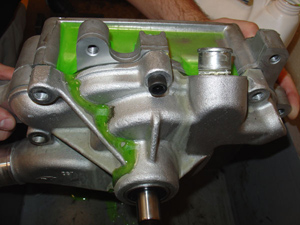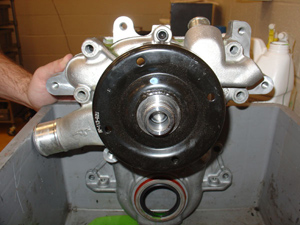Affected Vehicles/Engines:
1993-2003 Dodge trucks and Jeeps, 3.9L V6, 5.2L & 5.9L V8.
Condition:
A
coolant leak from a source above the water pump or from an improperly
installed bypass tube on the water pump itself will cause coolant to
pool on top of the timing cover. This coolant then rolls across the
front of the pump and behind the pulley, making the pump appear to leak
from the weep hole (Figure 1). This often results in unnecessary pump
replacement.
Cause:
The
pulley on this pump completely covers the face of the pump, making the
correct diagnosis difficult (Figure 2). The bypass tube that is shipped
loose in the box is often installed without sealant or is not tightened
properly. The subsequent leak can cause antifreeze to gather on top of
the timing cover,
which is difficult to see. There are other components above the water
pump, including the thermostat housing and the bypass hose, that can
leak and cause antifreeze to gather in the same place and eventually
mimic a leaking water pump.
Correction:
When
replacing this pump, the supplied bypass tube should be installed with
thread sealant and should be properly tightened before installation of
the pump. The bypass hose and clamp should be inspected for wear, holes
or other flaws before they are reused and the area should be inspected
for evidence of other leaks, such as from the thermostat housing. The
original leak that prompted the pump to be changed may still be present
and will need to be addressed.
– Tech Tip courtesy of ASC Industries, Inc.

For information on products offered by ASC Industries, visit www.asc-ind.com.













